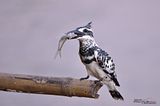Another post with old stuffs, this time's from Thailand. During my last visit to my hometown in Thailand, I've got a chance to visit Doi Angkang with 3 other members on the 11-12 September 2010. In the afternoon of September 11, we surprisingly came across a male Black-breasted Thrush (Turdus dissimilis) with a mouthful of earth worms at the first U-curve down from Fang-Angkang Checkpoint. It was very dark and misty, but we were all very eager to wait for the bird to show up again, as it is not normal to see it during this time of year, especially with that mouthful of worms. The bird has always been thought to be a winter visitor to northern Thailand. However, several singing records were reported from Doi Angkang in recent years, and some people began to question its status in Thailand. After we waited for the bird to appear for quite a while, a female bird then flew up from the hill down below with a mouthful of worms just like the male we first saw. It then led us to the nest hidden in the middle of a thick bush approximately 7 metres above the ground. We were really surprised and happy to be the ones who discover the first nest of this bird in Thailand!





Male Black-breasted Thrush (Turdus dissimilis)


It was almost impossible to spot the nest without the parent birds coming in. The nest was made of small dry twigs and woven into a cup. There were 3 chicks in the nest and all of them seemed to be only about a week old. We also observed the female sitting on the nest in order to warm the chicks up during the bad weather. The frequency of feeding mostly depended on time and weather. Parent birds seemed to feed the chicks more often during misty weather and late afternoon. During midday, the parents disappeared from the nesting ground for more than 50 minutes. Earthworm was the only prey that both parent birds brought back for the chicks. We later found the food source unexpectedly. It was a small roadside ditch in the hill below the nesting area. The female bird tended to be warier than the male when coming back to the nest. It would wait longer until it felt safe enough to come into the nest. Male bird showed more aggressive behaviour including giving aggressive call in front of one of our members. By observing through a telescope, we found that both parents ate up the fecal sacs of the chicks, right after they were fed. We also saw the male prodding softly on the chicks’ heads, especially the ones that were fed. The bird prodded repeatedly for 2-3 times in each feeding. Below is a video shot through a telescope showing both male and female birds feeding the chicks.


















.jpg)

7 comments:
Excellent, how nice this is to be able to witness the first nesting ever... The video is really cool!
I'm impressed that you tracked both birds in that thick cover and then found the nest. A first breeding record is a really good one to get.
Wow waht agreat discovery, congrats!
Hi Ayuwat,
Great video of the nesting bird. Couldn't have been easy finding the nest.
Thanks a lot everyone for your kind compliments!
Congratulation for the new discovery and another Thailand's first,Don,this is indeed a big surprise.I also thought they are winter visitor to Thailand before this,good to know now they are officially a new resident to northern Thailand.I've been to that area to search for the gorgeous Red Tailed Laughingthrush several times but only saw a pair of Chestnut Bellied Rock Thrush once 2 years ago.
Thanks a lot Jason. What's funny is that why we've always been thinking that it's a winter visitor through all these years, even when its nearest breeding ground is just the Shan State in Myanmar, just over a few mountains behind Doi Angkang!
Post a Comment